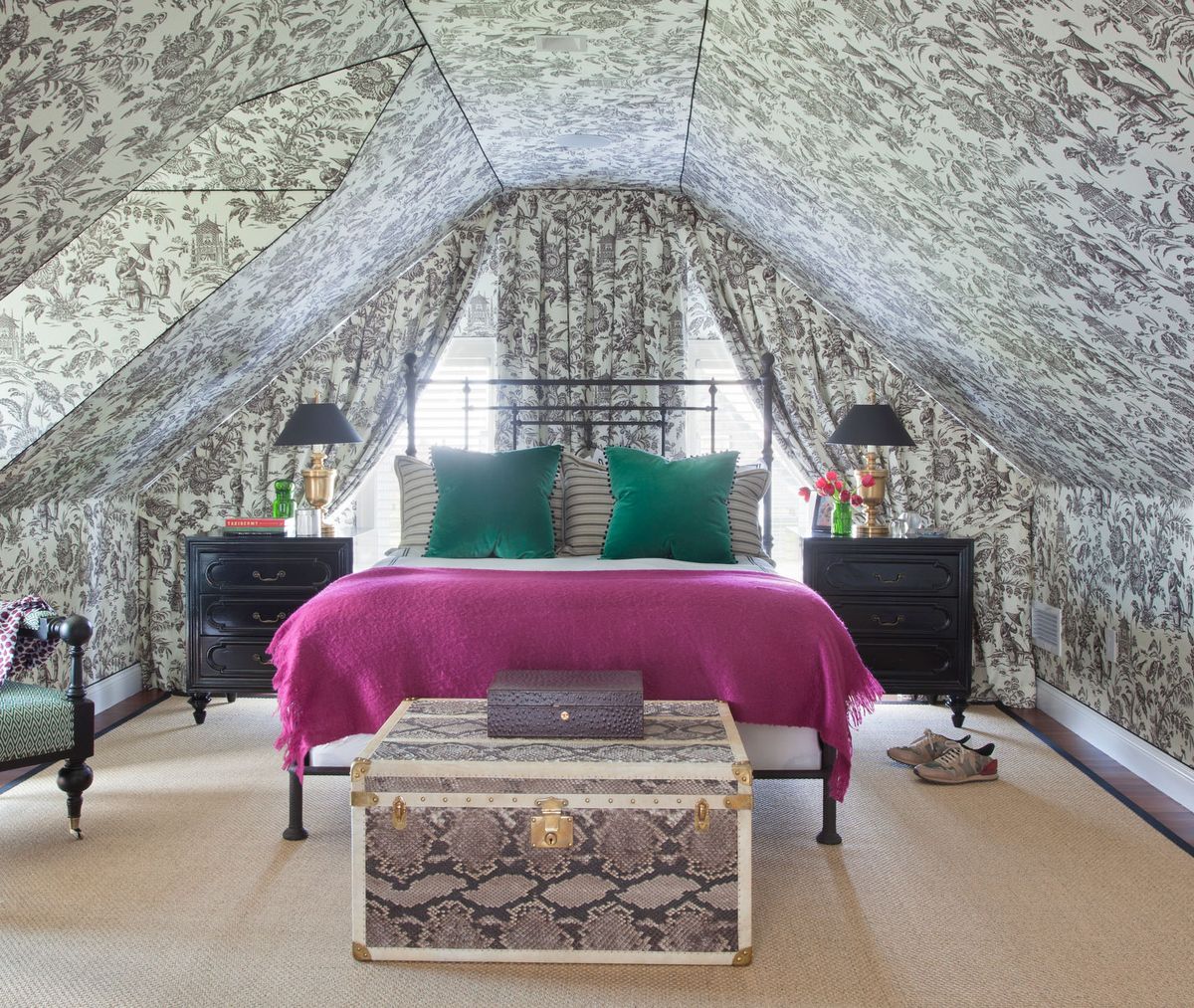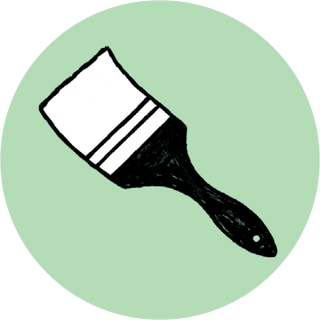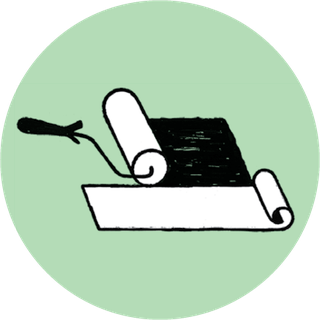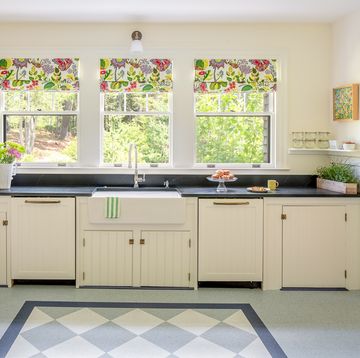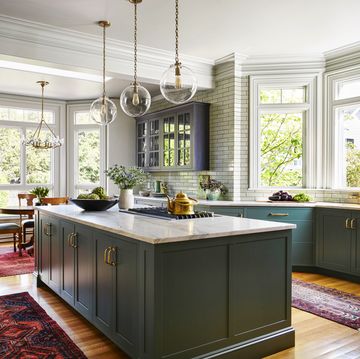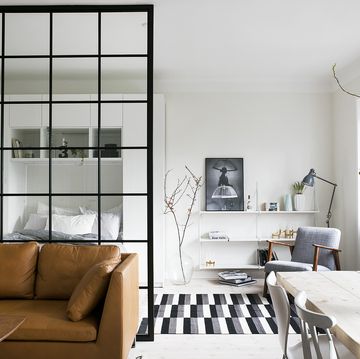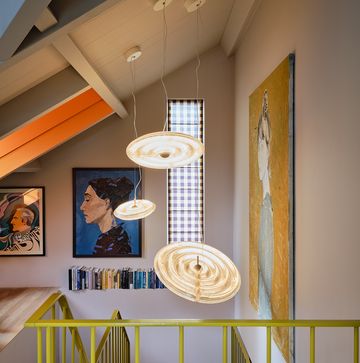When done right, wallpaper is beautiful, transformative, and timeless. And while the process of hanging pasted paper might seem complicated, it's actually pretty painless, making it totally worth the extra effort and investment. Once you understand the paper hanging process, hanging up wallpaper won’t be as daunting (no more The Yellow Wallpaper-associated nightmares). We spoke with Greg Laux, marketing committee chair of the Wallcovering Installers Association, to learn everything you need to know about the wallpaper installation process and how to hang paper so it will look good for years to come.
Pick Your Perfect Paste.
One of the most important steps is figuring out which glue to use, Laux says, so let's talk wallpaper pastes. Today, there are a ton of options optimized for both adhesion and easier removal. Here’s how to know which is best for your needs.
Pre-Mixed Wallpaper Paste: As Laux explains, “The premixed version takes the guesswork out of what your grandparents would have done: taking powdered wheat or cellulose, and mixing it in a bucket with clean water to make a starchy paste that would grab (and hold) the paper products, which they were sticking to the wall. But now, with an increase in Mylars and non-woven materials, along with classic fabric backed vinyls, the use of the pre-mixed adhesives is very common. That product is simply more consistent and it is far more productive to open a bucket and roll out the adhesive on any type of job site.”
Glue-Size: You’ll need this if your wall is newly plastered, because it primes and seals the new plaster, which prevents the plaster from soaking up all the adhesive and preps the wall for easier application. Basically, it makes sure the wallpaper will stick.
Heavy Duty: These types of adhesives dry quickly, which is great for heavier papers. It’s most compatible with heavy, high-grade wallpapers. It’s also much harder to remove, so keep that in mind if you plan on reselling your home or redecorating in the near future.
Cold Water: This is the most common type of paste. It comes in the form of a starch or wheat-based powder, which you or the installer mix with water. Though it sounds like a pain to mix it yourself, there’s a method to the madness: You can make it thicker, thinner, stronger, or weaker, depending on the weight of the paper you’re working with. It’s also water-soluble, which means it’s easy to remove when the time comes. These also have the longest drying times of all the pastes, which means more waiting but also more time to correct mistakes. So basically, if you're a pro, this is the stuff you'd want to use. If you're not, you may run into some issues.
Choose a Wallpaper With Backing.
Aside from wallpaper paste, understanding wallpaper backing can also ease your commitment concerns. Put simply, most wallpapers are now backed with a lining so they aren’t straight against the wall. As the Wallcoverings Association explains, the backing can be vinyl, paper, fabric or natural textile. This intermediary makes it a lot easier to apply, remove, replace, and paint over later, as it protects the wall from damage by preparing it for appropriate paste absorption.
Know When You Should Hire a Professional.
Designer Danielle Colding assures us that installation is so easy it can usually be done within a few hours in an average-sized room (and depending on what kind of glue is used). But—and this is a big but—only if a skilled professional is the one doing it. In fact, every designer we spoke to strongly recommended hiring a skilled paperhanger for a plethora of reasons, from mere aesthetic purposes to influencing resale value down the road. Think of it this way: If you’ve already selected a beautiful, high-quality wallpaper, it’s best to have a skilled craftsman handle it so it can live up to its full potential.
If you're not sure if you need to consult a professional or not, Wallcovering Association advises that you "match your particular skill level, wallpaper type, and complexity of application to give you a fair indication whether it’s time to call for help."
But if you're up to the challenge, we've got you covered too!
Ready to DIY? Here's How to Hang Wallpaper Yourself:
Make sure you have the right materials and tools first. Founder of modern wallpaper company Flat Vernacular Payton Cosell Turner says you'll need “a sharp knife, a good glue, a flat folding table, a soft cloth, a bucket of water, a tape measure, a level, a squeegee, and patience."
- Measure and cut
First of all, as in any good DIY, you'll need to carefully measure and cut your wallpaper accordingly. If you're hanging a patterned paper, you'll need to pay attention to the repeat, or the length before the pattern repeats. This is important to ensure the pattern lines up across multiple strips of wallpaper in a room. As the old axion goes, measure twice (or even three times!) and cut once. We'd also recommend numbering your wallpaper strips once they're cut to endure you paste them in the right order (and don't have to waste time mid-hanging trying to determine what piece comes next). You should also lay out each panel in front of the portion you're going to hang it so it's ready to go.
2. Prep and paste
Before hanging anything, you'll want to clean and sand the walls and, if necessary, prep them with a primer. Next, you'll roll on the paste gently (don't just dump a bunch on), starting in a corner. We recommend a paint roller for the best coverage. When you're ready to actually apply the paper, make sure you seam the corners (especially if it features a repeating pattern). This overlap will help you make sure the pattern meets evenly.
3. Smooth the paper
After you hang each panel, you'll want to gently run a smoother over every square inch of it. Don't push too hard down on the paper, though. As you apply, continue wiping down the paper with a sponge to wipe off glue residue. You'll also want to roll over each seam (the edges where two panels meet). Once it's smooth, cut any excess paper.
4. Let it dry
Then let it dry! Curing usually takes at least 24-28 hours, but giving it a week before you touch it or hang anything on it is a good way to play it safe.
What to Wallpaper?
Into the wallpaper look but don't have a wall that's right for it? There are plenty of other places to apply it—even as a testing ground before moving onto a larger surface! Here are some suggestions:
- Closet doors: A floral wallpaper and doorframe painted a bold color give blah doors the look of chinoiserie panels.
- Stairs: Whether you decide to swathe the risers or the side of the staircase (like Grace Mitchell did here), a pretty paper on the stairs makes for an unexpected design element.
- Cabinets: For a patterned pop, wallpaper inside your cabinets—here's how.
Need to Remove it?
Surprise twist and fabulous news: Removal is slightly easier. Here's a simple step-by-step guide for how to remove wallpaper. Check out The Wallcovering Installers Association to find a paperhanger in your area who can help you out.
Follow House Beautiful on Instagram.

Hadley Mendelsohn is the co-host and executive producer of the podcast Dark House. When she's not busy writing about interiors, you can find her scouring vintage stores, reading, researching ghost stories, or stumbling about because she probably lost her glasses again. Along with interior design, she writes about everything from travel to entertainment, beauty, social issues, relationships, fashion, food, and on very special occasions, witches, ghosts, and other Halloween haunts. Her work has also been published in MyDomaine, Who What Wear, Man Repeller, Matches Fashion, Byrdie, and more.
Hadley Keller is the Director of Editorial and Community Engagement at the Design Leadership Network, a community of top interior designers. She has covered design, interiors, and culture for over 10 years.
